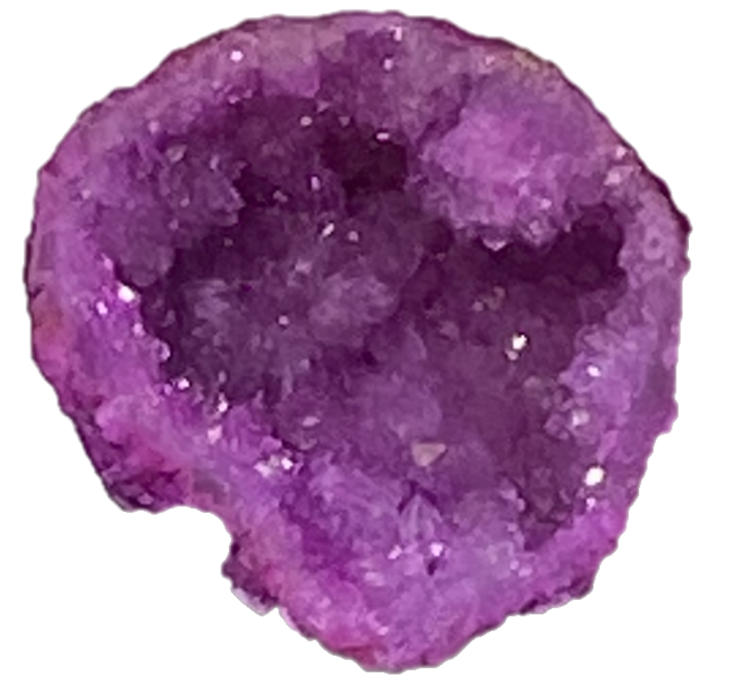
The term “geode” originates from the Greek word “geōdēs,” meaning “earthlike.” This name reflects the stone’s unassuming, rock-like exterior, which conceals a spectacular crystal-lined cavity within. Geodes are sometimes referred to as “thunder eggs,” particularly when they are completely filled rather than hollow. Other names include “crystal geodes” and “druzy geodes,” depending on the crystal formation inside.
Composition and Physical Characteristics
Geodes are spherical to oblong rock formations with a hollow cavity lined with minerals. Their outer shell is typically composed of sedimentary or volcanic rock, such as limestone, basalt, or rhyolite. The interior, however, often showcases stunning crystalline structures, usually composed of quartz, amethyst, calcite, agate, or other minerals. The variation in mineral deposits leads to a breathtaking array of colours and textures, making each geode unique.
Geodes have a hollow space inside, or once had a hollow space inside that was filled with water based mineral material.
Nodules May have been at one time a geode but are now just solid objects composed of water mineral material. They might also have formed by mineral growth on a sediment surface, growth within a cavity, or by replacement of their host rock.
Vugs are cavities that might contain crystals, but they do not have a lining that allows them to separate from their host rock. Unlike geodes, they will not exist after the host rock is weathered away.
Concretions are solid aggregates composed of sediment grains and a cementing material. They form when mineral based water begins around a central core in the sediment, such as a fossil or a mineral grain. More and more material accumulates around the centre, essentially growing from the centre and they enlarge outwards without a cavity.
Thundereggs are masses of rhyolite that weather out of volcanic strata. They have an internal cavity that has been infilled with agate, opal or other mineral material. Thundereggs rarely contain mineral crystals growing into a void.
Varieties of Geodes
Quartz Geodes – Lined with clear or milky quartz crystals.
Amethyst Geodes – Contain deep purple amethyst crystals.
Agate Geodes – Feature banded chalcedony (agate) interiors.
Calcite Geodes – Filled with golden to white calcite formations.
Celestite Geodes – Contain delicate blue celestite crystals.Fluorite Geodes – Display vibrant hues of green, purple and blue.
Locations Where Geodes Are Found
Geodes are discovered in various locations worldwide, particularly in regions with volcanic activity or sedimentary deposits. Notable locations include:
- United States: Iowa, Indiana, Kentucky, Utah, and Arizona.
- Mexico: Chihuahua and Zacatecas.
- Brazil: Renowned for massive amethyst geodes.
- Uruguay: Famous for high-quality amethyst and quartz geodes.
- Morocco: Known for celestite geodes.
- Spain, Namibia, Madagascar, and India also produce stunning geodes.
Archaeological and Significant Finds
Geodes have been treasured for centuries, with archaeological finds suggesting their use by ancient civilisations for both practical and spiritual purposes. Native American tribes used geodes in ceremonies, while ancient Egyptians believed geodes harnessed the power of the gods. Some of the most remarkable geodes, including enormous amethyst geodes over 10 feet tall, have been unearthed in Brazil and Uruguay.
Historical and Current Usage
Historically, geodes were used for protection, meditation, and decorative purposes. Today, they remain popular in:
- Home Decor: Displayed as natural art pieces.
- Jewellery: Used in pendants, rings, and bracelets.
- Metaphysical Practices: Believed to enhance energy and healing.
- Education: Used in geology studies to demonstrate mineral formation.
Interesting Facts
- Some geodes take millions of years to form.
- The largest amethyst geode ever found, known as the “Empress of Uruguay,” is over three metres tall.
- Geodes are often created from gas bubbles in lava, which slowly fill with mineral-rich water over time.
- They can be artificially dyed to enhance their appearance, though many prefer natural geodes.
Folklore, Legends, and Tales
Geodes have been linked to various legends and spiritual beliefs:
- Native American Lore: Some tribes believe geodes house the spirits of the earth, offering wisdom and protection.
- European Myths: Geodes were considered dragon eggs that could reveal mystical energies when cracked open.
- Ancient Beliefs: Some cultures saw geodes as conduits to the divine, containing celestial energy within their crystalline hearts.
Many see geodes as a feminine property due to the cavity which could represent the womb. Geodes can help communicate with divine beings and assist in creating better moods, balances, and energies that can help with meditation, stress, and decision-making.
Mystical Healing Properties
Geodes are highly regarded in crystal healing practices:
- Energy Amplification: Thought to amplify surrounding energies.
- Emotional Balance: Believed to aid stress relief and inner peace.
- Creativity Boost: Associated with enhanced imagination and inspiration.
- Healing and Protection: Used in meditation and chakra balancing.
Links with Astrology and the Zodiac
Different geode types are associated with various zodiac signs:
- Amethyst Geodes – Linked to Pisces and Aquarius.
- Quartz Geodes – Resonates with all signs, especially Aries and Leo.
- Agate Geodes – Associated with Gemini and Virgo.
- Celestite Geodes – Connected to Gemini and Libra.
The Chakra System
Geodes influence multiple chakras depending on their mineral composition:
- Amethyst Geodes – Crown Chakra (spiritual insight, intuition).
- Quartz Geodes – All Chakras (energy balancing, clarity).
- Agate Geodes – Root and Sacral Chakras (stability, creativity).
- Celestite Geodes – Throat Chakra (communication, expression).
Birthstone and Wedding Anniversary Links
Wedding Anniversary: Geodes, especially those containing quartz or amethyst, make unique gifts for the 6th and 7th wedding anniversaries.
Birthstone: Amethyst geodes are associated with February, while quartz geodes align with April.
